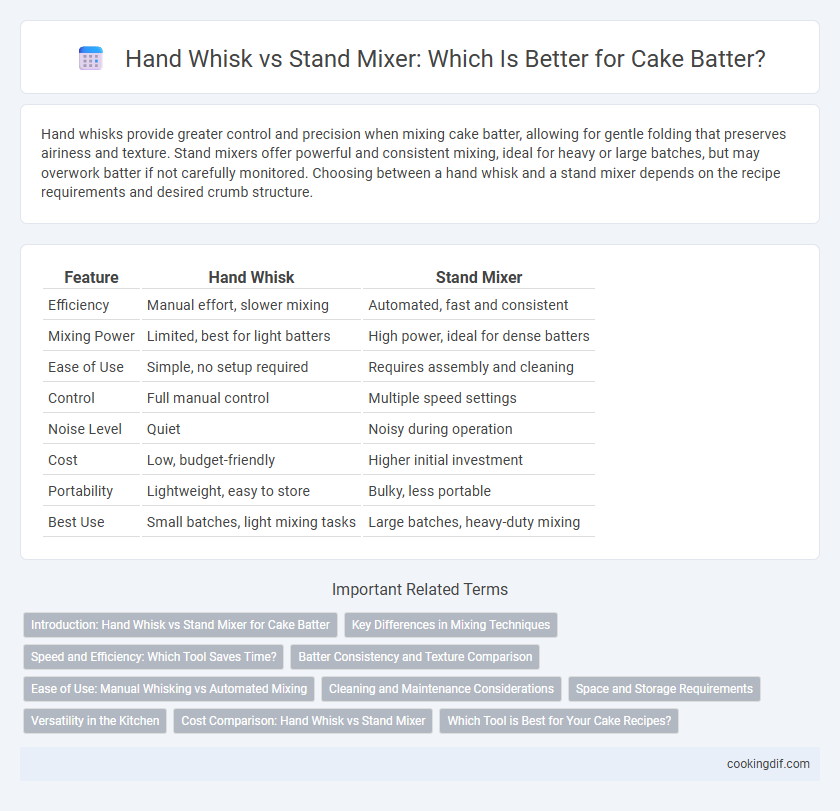Hand whisks provide greater control and precision when mixing cake batter, allowing for gentle folding that preserves airiness and texture. Stand mixers offer powerful and consistent mixing, ideal for heavy or large batches, but may overwork batter if not carefully monitored. Choosing between a hand whisk and a stand mixer depends on the recipe requirements and desired crumb structure.
Table of Comparison
| Feature | Hand Whisk | Stand Mixer |
|---|---|---|
| Efficiency | Manual effort, slower mixing | Automated, fast and consistent |
| Mixing Power | Limited, best for light batters | High power, ideal for dense batters |
| Ease of Use | Simple, no setup required | Requires assembly and cleaning |
| Control | Full manual control | Multiple speed settings |
| Noise Level | Quiet | Noisy during operation |
| Cost | Low, budget-friendly | Higher initial investment |
| Portability | Lightweight, easy to store | Bulky, less portable |
| Best Use | Small batches, light mixing tasks | Large batches, heavy-duty mixing |
Introduction: Hand Whisk vs Stand Mixer for Cake Batter
Choosing between a hand whisk and a stand mixer for cake batter significantly impacts texture and mixing efficiency. Hand whisks require manual effort and provide greater control, ideal for small batches or delicate folding techniques, while stand mixers offer powerful, consistent mixing suited for larger quantities and more complex recipes. Understanding the specific needs of your cake batter--such as aeration, volume, and ingredient integration--guides the best tool selection for optimal baking results.
Key Differences in Mixing Techniques
Hand whisks provide manual control and a gentler mixing process, ideal for delicate batters that require minimal aeration. Stand mixers use motorized power and various speed settings to achieve consistent, thorough mixing, making them suitable for dense and heavy batters. The key difference lies in the mixing intensity and efficiency, where hand whisks offer precision and texture control, while stand mixers deliver speed and uniformity.
Speed and Efficiency: Which Tool Saves Time?
Hand whisks require more manual effort and generally take longer to mix batter thoroughly, making them less efficient for large or dense cakes. Stand mixers operate at higher speeds with powerful motors, significantly reducing mixing time and delivering consistent results swiftly. For time-saving and efficient batter preparation, especially in baking environments demanding volume or precision, stand mixers are the superior choice.
Batter Consistency and Texture Comparison
A hand whisk allows precise control over batter consistency, ideal for lighter, airier textures like sponge cakes, as it incorporates air gradually without overmixing. Stand mixers provide powerful, consistent mixing suited for denser batters, ensuring thorough ingredient integration and smooth texture, which benefits recipes such as pound cakes and butter cakes. The choice impacts crumb structure: hand whisking yields delicate, tender results, while stand mixing often produces uniform, stable batters with enhanced volume.
Ease of Use: Manual Whisking vs Automated Mixing
Hand whisks offer precise control and a tactile feel, making them ideal for small batches or delicate batters but require more physical effort and time. Stand mixers automate the mixing process, significantly reducing effort and mixing time while ensuring consistent, even batter texture, especially useful for larger quantities. Ease of use is enhanced with stand mixers due to adjustable speeds and hands-free operation, whereas manual whisks demand continuous attention and skill to achieve optimal results.
Cleaning and Maintenance Considerations
Hand whisks require minimal cleaning effort, often needing just a quick rinse or wash with warm soapy water, making them ideal for small batches or quick tasks. Stand mixers involve more components such as beaters, bowls, and attachments that must be thoroughly cleaned after each use to prevent buildup and maintain performance. Regular maintenance, including checking motor vents and lubricating moving parts, is essential for stand mixers to ensure long-term durability and optimal mixing results.
Space and Storage Requirements
Hand whisks are compact and lightweight, making them ideal for kitchens with limited space and minimal storage options. Stand mixers, while bulkier and requiring a dedicated countertop area, offer multiple attachments and functionalities, reducing the need for additional tools. Choosing a hand whisk saves storage space, whereas a stand mixer demands more room but enhances versatility in baking tasks.
Versatility in the Kitchen
A hand whisk offers precision and control for small to medium batches, making it ideal for delicate tasks like whipping egg whites or mixing light batters. Stand mixers provide unparalleled versatility with multiple attachments and powerful motors, handling heavy doughs and large quantities effortlessly. Choosing between them depends on kitchen space, mixing needs, and the variety of recipes you frequently prepare.
Cost Comparison: Hand Whisk vs Stand Mixer
Hand whisks generally cost between $5 and $20, making them an affordable option for casual bakers or those with limited kitchen space. Stand mixers, with prices ranging from $150 to over $500, represent a higher initial investment but offer multi-functional features and consistent mixing power for frequent use. Budget-conscious bakers should weigh the one-time expense of a stand mixer against the manual effort and lower upfront cost of a hand whisk when deciding which tool suits their baking needs.
Which Tool is Best for Your Cake Recipes?
A hand whisk offers precise control and is ideal for small batches or delicate batters that require gentle mixing, preserving airiness in sponge cakes. Stand mixers provide consistent speed and power, making them perfect for denser batters or larger quantities, ensuring thorough ingredient incorporation without fatigue. Choosing between a hand whisk and a stand mixer depends on your recipe requirements, batch size, and desired texture for the perfect cake outcome.
Hand whisk vs Stand mixer for batter Infographic

 cookingdif.com
cookingdif.com